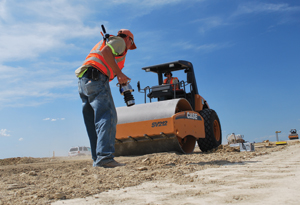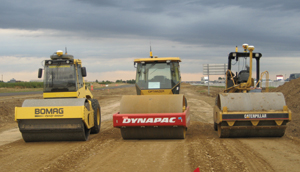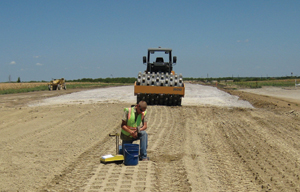Nationwide research is firming up the case for “intelligent” compaction, or IC, a construction method three decades in the making that could save billions of dollars a year in potholed roads, cracked bridges, broken dams and blown-out tires. But as it represents a huge cultural shift in project delivery, the industry is struggling to find a standard way to roll it out.



David White, a professor at Iowa State University, Ames, and director of the school’s Earthworks Engineering Research Center, estimates that the stiffness of soil, sand and aggregate—the building blocks of road embankments, building pads and bridge abutments—cost the public up to $100 billion a year due to poor construction.
“There is something like $50 billion a year for vehicle maintenance because of poor road conditions,” he says. “Those poor road conditions are tied to what they are sitting on.” At the very least, improper compaction costs taxpayers $1 billion a year in wasted diesel fuel, construction labor, equipment maintenance, rework, rehabilitation, litigation and other inefficiencies.
IC in its simplest form is an onboard measuring device that shows roller operators whether they are overcompacting, undercompacting or right on target in soil, aggregate and asphalt. Some machines go another step by automatically changing frequency, amplitude or other characteristics of the drum. How users define “intelligence” is still up for debate, but the construction industry is investing millions of dollars to validate IC.
Government agencies are working to write specifications so they can let contracts enabling IC. So far, Minnesota is the only state to do so, though its specification is still under regular revision and is careful not to mandate IC due to the high up-front cost to contractors.
Louder Drumbeats Originally pioneered and adopted in Europe, IC recently has grown out of automated machine guidance, or AMG, which grew out of the increased use of the Global Positioning System in the U.S.
IC puts roller operators directly in charge of ground control, enabling them to inspect their own work before turning it over to the owner for verification and payment. The increasing use of IC onexperimental highway projects over the past five years is steadily giving state departments of transportation more confidence the technology can cut construction waste and extend the life of roads and other infrastructure. Though IC likely will not render traditional inspection instruments, such as the nuclear-density gauge, obsolete, IC is in a position to grow as a 21st-century quality-control/quality-assurance tool.
So far, smart compaction machinery is turning out to be excellent for “proof” rolling, engineers say. “We are trying to measure and predict how [roads] will behave when a truck runs over the material,” explains John Siekmeier, a senior research engineer for the Minnesota Dept. of Transportation. “The roller is really a better simulation of how well that material will behave over the long term, over the itty-bitty, nuclear-density gauge.”
The instrumented rollers cost about 20% more than their non-instrumented counterparts but can pay off in the first job, proponents say. When poor compaction is found underneath graded aggregate or pavement, “$20,000 gets eaten up pretty fast” when you need to remediate, says Dave Dennison, product manager for Kewanee, Ill.-based roller maker Bomag Americas.
Contractors, which tend to overcompact to save face, see IC as a way to increase profits while helping taxpayers save. “If you can compact your embankments right, these roads will last 25 to 30 years longer,” says Dwayne McAninch, chairman of West Des Moines-based earthmover McAninch Corp.


Post a comment to this article
Report Abusive Comment